
The Most Ailurophile Culture
Cats are mostly known as independent and freedom loving creatures. These wayward animals that have always had a detached way of living, have also been long admired by humans. Cats were seen as graceful, selfish, cunning and clever creatures who live only for their own pleasure. However cats enjoy their coziness and are more attached to the home than to the owner (if we consider cats as pets). The cat always, always comes back home but not necessarily to the host or owner.
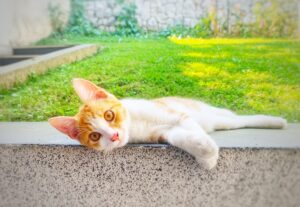
Slavic people have always had a thing for these loving and intimidating creatures. Cats played an important role in their mythologies, superstitions and numerous folk tales.
One of many colorful characters in a large number of Slavic hero tales is the cat “Bayun” who was always portrayed as a man-eating cat of enormous size. This cruel, scary cat loved to sit on a pole, most often an iron one. Basking in the sun, he patiently waited for travelers. Seeing a wandering pilgrim, Bayun began to purr, anticipating pleasure. The unsuspecting traveler approached the cat who, while fluffing its tail, began to tell tales and legends in a quiet, beautiful voice.
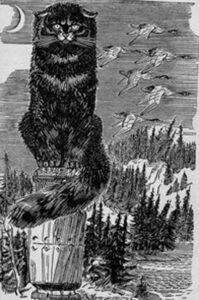
Bayun’s voice possessed magical powers. He lulled a person, plunged him into slumber, made him pliable and defenseless. In the end, the traveler fell asleep soundly and the terrible cat jumped from its pillar, released huge strong claws, tore the unfortunate man into pieces and ate the warm flesh; a rapacious carnivore enjoying a fresh meal.
The word “bayun” itself has been associated with talkative and fluffy men. It came from the Russian verb ‘bayat’ – to lull. And that is the reason this cat from terrible, horrific tales was given such a nickname. After all, Bayun was engaged in lulling, putting a person to sleep and then committing violent actions and taking lives.
This cannibalistic, man-eating character lived in the distant thirtieth kingdom surrounded by a dense forest, where there were no animals or birds. The thicket at the entrance to Bayun’s lair was cut by a narrow road leading to a post where Bayun sat. It was believed that if someone defeated the cat, he would receive salvation from all diseases. Therefore many men went to this distant kingdom, planning to win a victory over the monster, but died, intoxicated by Bayun’s magical voice.
To the early Slavs, cats were powerful animals in the fight against evil spirits and often compared to Veles, god of lowlands, underworld, cattle and the opposite of the incarnation of the god Perun, which was light. The cat’s confrontation with the mouse represented the eternal struggle between good and evil, the light of the world and wickedness of the underworld. That attachment added to their independent spirit and power against the spirits and it was a major reason they were admired by the early Slavs. The hairy cat is a symbol of Veles, the patron of animals of the ancient Slavs and the link to the other world which is able to recognize evil spirits and drive them away.
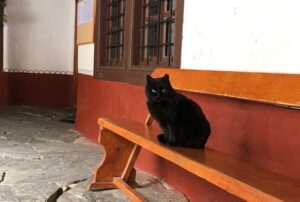
Among older Slavs, cats caused awe, respect, fear, and admiration which was not unusual considering cats were supposed to possess God-like attributes by the Slav civilizations.
Today, cats are still a very powerful and important symbol in Slavic culture as well as worldwide. Many ancient superstitions and even modern folktales involve cats as an ‘enemy’ and something that brings bad luck if seen crossing the road in front of you. To avoid the bad luck, you are supposed to turn around while glancing over your left shoulder three times and spit over the same shoulder three times. Analysis of the custom says the turning and spitting is interesting especially because it must be done specifically over one’s left shoulder. The practice seems to be almost an attempt to reverse time, as if it to undo the effects of the bad luck.
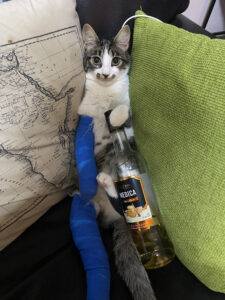
Also there is worldwide stereotypical depiction of the perpetually single “cat lady.” To this well known stereotype, Slavs added “crazy and old” referring to an image of elderly person without family surrounded and completely dedicated to cats that she often refers to as “children.”
Some other Slavic superstitious cat stories hypothesize that if a cat jumps over a ‘fresh’ grave, the deceased will rise from the tomb and become a vampire. Therefore, a coffin has to always be protected and sheltered from cats (on its way to graveyard).
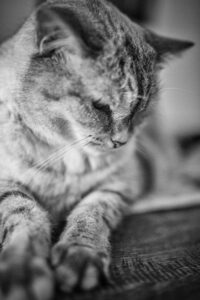
However in some parts of the world it is believed that black cats can actually improve one’s love life. English people claim if you give a black cat to a bride it will bring happiness to a marriage.
Specific black cat superstitions are very familiar to people all around world. According to the British, black cats can improve your life, amp up your good luck, and improve your finances, too. Historically, sailors brought cats abroad on ships to hunt mice – and, presumably, for companionship – but British sailors believed a black cat would bring the ship good luck and ensure a safe return home. However, for pirates, as with Slavs, it was a bit more complicated. They believed a black cat walking toward you was bad luck, a black cat walking away from you was good luck, and if a cat boarded the ship and then jumped off, the ship was going to sink.
In many countries, a black cat is also seen as audience and if spotted near the stage it mostly means success. In Japan, figures of cats of happiness or Maneko Neko with their paws up should bring luck and joy to everyone.
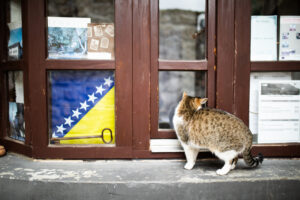
Of all the Slavic peoples, the Russians were the most enthusiastic “cat fans” – Russia was the only nation where more that half of the population claimed they had cats.
When most people think about cat breeds originating in Russia, they usually think of the Russian Blue, as if that’s the only unique Russian cat breed. Actually, there are dozens of feline breeds and sub-breeds native to this Slavic country. All of theses breeds come with their own unique temperament and physical characteristics.
Russia is the only country that has a theatre of cats called the Kuklachev Cat Theatre. All this unusual theatre, acrobatic cats do all kinds of stunts for audience’s delight. Yury Kuklachev says “We don’t use the word ‘train’ here because it implies forcing an animal to do something and you cannot force cats to do anything they don’t want to. We play with cats.”
The Slavic relationship with cats has been built on superstition, and remains strong and dynamic today. It might be bad luck when a black cat crosses a Slav’s path, but it seems it is worse luck to allow old superstitions to cause a Slav to lose out on the companionship of such a fickle, but entertaining animal.
To read more about Slav history and culture, click here.
- December 7, 2020
- Bulgaria , Bosnia and Herzegovina , Serbia , Slovenia , Croatia , Montenegro
